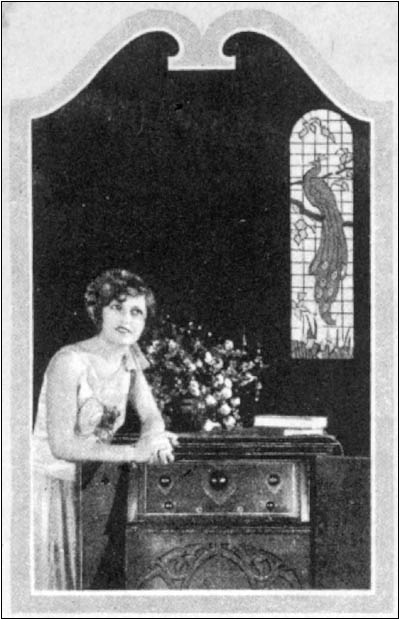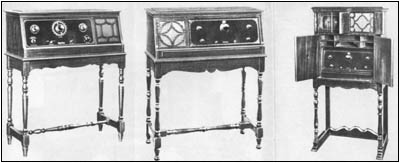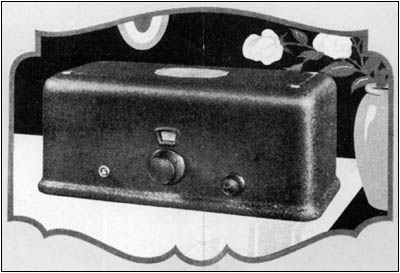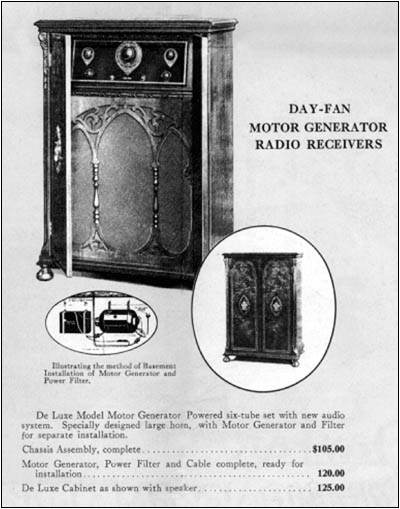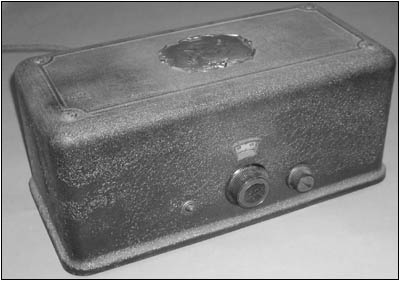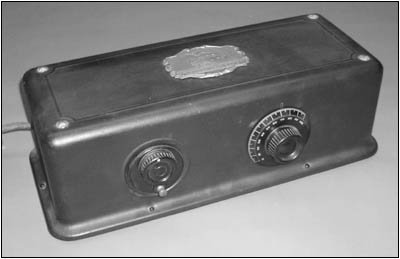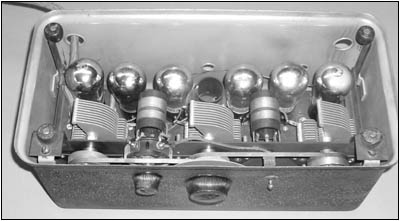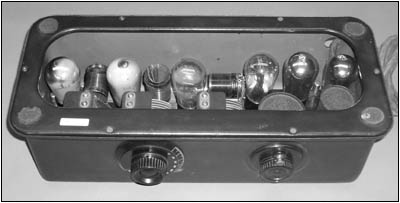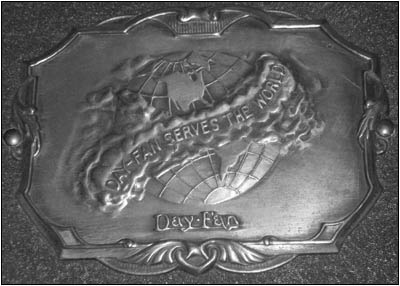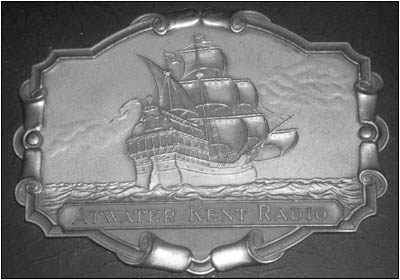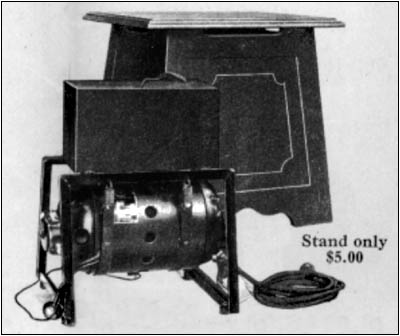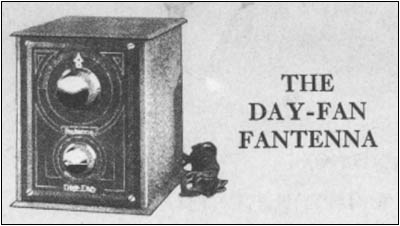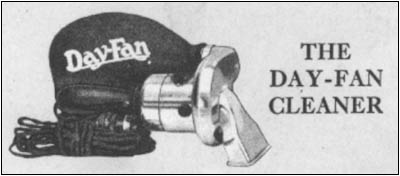Of Old Radios And Related Items--Published Monthly
Day-Fan Radio
BY DOROTHY SCHECTER and the A.R.C. Staff
WEB EDITION
Founded in Dayton, Ohio, in 1889, the Dayton Fan and Motor Company made fly and ventilating fans. In the 1920s, as the Day-Fan Electric Company, it began to join in the rush to capitalize on the growth of radio with a line of components. Ultimately, the company was bought by General Motors in 1929, and General Motors Radio Corp. was created. This company was liquidated in 1931 as a result of an antitrust suit involving GM's alleged collusion with RCA. (Editor)
A slightly tattered but very together Day-Fan Electric Company brochure from the John Terrey collection inspired this article. The handy 3" x 6" brochure opens first to two, then to four, and finally to eight panels. The back panel is stamped with the name "Dewey F. Kysow, Spec. Rep., Fanburg, Wis." One can easily imagine Dewey opening the brochure and launching into his salespitch about the "most efficient, dependable, and service-less radio set on the market."
Figure 1. Ethylne Clair, Universal Pictures Star, enjoying Day-Fan Radio.The lure of the lovely lady enjoying her Day-Fan radio on the cover, reproduced here as Figure 1, reminds us that times haven't really changed. As the Madison Ave. maxim goes, "sex sells," and so Ms. Ethlyne Clair, "a Universal Pictures Star," touted the Day-Fan wares then just as celebrities do the products of today.
New Audio Amplifying System
The first two panels of the brochure are straight text describing the strides made in research and engineering during the six successful seasons of producing Day-Fan radio receivers. The goal was to reproduce the same high quality broadcast program in the home as in the radio station itself.
To do this, the company claimed to have created an entirely new audio amplifying system "employed exclusively in Day-Fan receivers and the better class of broadcasting stations." This new system included a long list of attributes: a minimum of distortion, a wide band of high-to-low musical notes, unequalled tone qualities, greater stability, ease of volume control, great selectivity, and beauty of design and craftsmanship. These were additions to the already well-known Day-Fan features of factory logging and single-dial control with possible independent adjustment of the first and third condensers.
Figure 2. Left to right are the Day-Craft 5, the Day-Cee 6 and the Day-Royal 6 A.C. receivers.The final salespitch contained in these two panels is that the success of this system was evident in its appeal to a large number of broadcasting stations as the "official set for monitoring or checking their own programs." The hope was that the buyer of a home set looking for value would naturally take radio station endorsement as an excellent recommendation.
Day-Fan AC Tube Receivers
Next is the four-panel foldout displaying a Day-Craft 5 AC receiver, a Day-Cee 6 receiver, and a Day-Royal 6 AC receiver, all containing the above audio system, and shown in Figure 2. According to the blurb on the first panel, these AC tube model sets owed their increasing popularity to ease of installation, freedom from gradually failing battery current supply, and very low cost of operation. When the set was connected to a Day-Fan designed "B" and "C" power supply, and after supplying the proper tubes, the purchaser had only to plug the set into the lighting circuit and connect aerial and ground wires -- "no batteries... no acids... no recharging... no bother."
Figure 3. The Day-Fan 6 Jr., a 6-tube battery set, sold for $65.The Day-Craft 5 receiver with built-in speaker and B and C power supply unit for 60-cycle, less tubes, sold for $170; with 25- and 30-cycle current supply for $180, and without legs for $150. The 6-tube Day-Cee receiver, with the famous organ pipe loudspeaker, sold for $140. Various accessories ranged in price from $45 to $105. The Day-Royal 6, with full-toned built-in speaker, and B and C power supply that could be placed in the cabinet, sold for $195. The handsome cabinet alone was a strong selling point for the home.
An Array of Products
Figure 4. The De Luxe Model Motor Generator-Powered 6-tube set shown in the optional De Luxe cabinet.Finally, the full, inside eight-panel foldout presents an array of radios and accessories, from the "bargain" Day-Fan 6 Jr. battery set to complete A.C. sets using motor generators and/or power supply units and various accessories.
The Day-Fan 6 Jr., shown in Figure 3, was a "Compact, efficient receiver developed in answer to an insistent demand for just such a set." This set sold for $65, while the next least expensive set is the 6-tube chassis assembly for the DeLuxe Model motor generator-powered receiver selling at $105.
This set, with new audio system, in a handsome cabinet with speaker is shown in Figure 4. The De Luxe cabinet, shown with the set, with a specially designed large horn speaker, sold for an additional $125. The motor generator sold separately for another $120, which brought the total cost to $350.
The text explains that the motor generator power unit and special motor generator set have been perfected after four years of experimental and developmental work in the Day-Fan laboratory -- a year ahead of schedule! "Motor generator production of direct current from alternating has been proved the most efficient and economical ever devised." Such a set is easy to install as it is ready to perform with great dependability after you connect three separable plugs.
Day-Fan 6 Junior and Atwater Kent 35
The Day-Fan 6 Jr., a 6-tube TRF introduced in 1927, is similar in style to the Atwater Kent 35 introduced the previous year.
The Atwater Kent Model 35, a 6-tube TRF, was introduced in 1926, and is commonly referred to as the "bathtub set."The Day-Fan Model 6 Jr., bears a strong resemblance to the Atwater Kent Model 35. While there are some differences between the two radios, there are strong similarities. Both are 6-tube TRF sets with an untuned 1st RF stage. Filament circuitry is the same in both sets. Filament voltage to the three RF stages is controlled by a rheostat. A fixed resistor is placed in series with the filaments of the detector and AF stages. Both radios are housed in metal cabinets and use an inverted chassis. Both sets have emblems on the top of their cabinets.
There are so many similarities, it would seem that Day-Fan drew heavily on the design of the Atwater Kent 35 that was produced about a year earlier than the Day-Fan set.
An underside view of the Day-Fan 6 Jr., showing the upside-down chassis and tubes, similar to those of the Atwater Kent Model 35.
An underside view of the Atwater Kent Model 35 showing the upside-down chassis and tubes.
The emblems on the Day-Fan, shown on the top, and the Atwater Kent, shown on the bottom continue the similarity.For a lucky owner, service and cost of operation are minimal on these sets. Once a year, he simply has to oil the motor generator and then forget it. He can even feel free to go on an extended trip, after which his set would still work perfectly -- "no sulphated storage batteries, corroded wires, or dead B and C batteries."
The motor generator, shown in Figure 5, was sold as a separate accessory for $120. And, homes with 32-volt and 110-volt DC current do not need a motor generator to operate the set. For 110-volt DC, only the special DC receiver itself and a filter block are required. The latter piece of equipment is unnecessary for 32-volt DC current.
Figure 5. The motor generator and power filter shown in front is for use in a basement, or it can be concealed in the optional "tabouret" in the rear.
Figure 6. "A thoroughly proved accessory that increases the volume, range and clarity of six and seven-tube receivers, at no extra maintenance cost. Installed in two minutes. Price..$15.00."
Figure 7. The brochure states: "A one-handed electric Vacuum Cleaner that performs an unbelievable number of household cleaning tasks at practically no operating cost. Price..$18.75."The collector may notice a striking resemblance of the Day-Fan 6 Jr. to the Atwater Kent Model 35, which is in a similarly shaped metal cabinet. In fact, both the Day-Fan and Atwater Kent sets had the chassis (and also the tubes) installed upside down. The following two pages feature a comparison of these two sets, which are from the John V. Terrey collection.
Accessories
To fill the back panel of the brochure, Day-Fan threw in three interesting accessories. A Day-Fan "Fantenna," shown in Figure 6, increased the volume, range and clarity of 6- and 7-tube receivers at no extra maintenance cost. The Fantenna consists of a 2-control tuned circuit that connects to antenna and ground connections of the 6- and 7-tube Day-Fan radios for improved reception. These radios employ an untuned 1st RF stage. Easy 2-minute installation was a selling point and the $15 price tag was modest enough.
The Day-Fan "Quietus," not shown here, selling at $10, eliminated interference noises caused by electrical household appliances, such as washing machines, refrigerators, etc. That list no doubt included the third item on the panel -- a hand-operated vacuum cleaner.
Just in case the customer wasn't interested in a radio, he could give some thought to this Day-Fan cleaner, shown in Figure 7, which "performs an unbelievable number of household cleaning tasks at practically no operating cost." A regular model for 110 volts cost only $18.75. A special for 220 volts, either AC or DC, or 32 volts, DC only, was priced at $21.
Obviously, Day-Fan was awash in bargains. We can only hope that this little brochure helped to make Dewey F. Kysow's fortune.
References:
Day-Fan Radio Brochure. The John V. Terrey Collection.
Douglas, Alan. Radio Manufacturers of the 1920's. Vestal, New York: The Vestal Press, 1988.
(Dorothy Schecter, c/o A.R.C., P.O. Box 2, Carlisle, MA 01741)
| [Free Sample] [Books, etc., For Sale] [Subscribe to A.R.C./Renew] [Classified Ads] [Auction Prices] [Event Calendar] [Links] [Home] [Issue Archives] [Book Reviews] [Subscription Information] [A.R.C. FAQ] URL = http://www.antiqueradio.com/Jan05_Schecter_DayFan.html Copyright © 1996-2005 by John V. Terrey - For personal use only. Last revised: December 24, 2004. For Customer Assistance please contact ARC@antiqueradio.com or call (866) 371-0512 Pages designed/maintained by Wayward Fluffy Publications
Antique Radio Classified |
